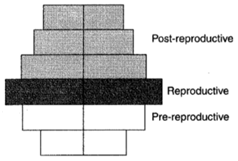The population of an insect species shows an explosive increase in number during rainy season followed by its disappearance at the end of the season. What does this show?
1.
The population of its predators increases enormously
2.
S-shaped or sigmoid growth of this insect
3.
The food plants mature and die at the end of the rainy season
4.
Its population growth curve is of J-type

To unlock all the explanations of 38 chapters you need to be enrolled in MasterClass Course.

To unlock all the explanations of 38 chapters you need to be enrolled in MasterClass Course.
Graph below is a diagrammatic representation of response of organisms to biotic factors. What do a,b,c represent respectively?

1. Partial regulator, conformer, regulator
2. Regulator, conformer, Partial regulator
3. Conformer, regulator, Partial, regulator
4. Regulator, Partial conformer, regulator

To unlock all the explanations of 38 chapters you need to be enrolled in MasterClass Course.

To unlock all the explanations of 38 chapters you need to be enrolled in MasterClass Course.
What type of human population is represented by the following age pyramid?

1. Expanding population
2. Vanishing population
3. Stable population
4. Declining population

To unlock all the explanations of 38 chapters you need to be enrolled in MasterClass Course.

To unlock all the explanations of 38 chapters you need to be enrolled in MasterClass Course.
The logistic population growth is expressed by the equation:
1. \(\dfrac{dN}{dt} = rn \left(\dfrac{N - K}{N}\right)\)
2. \(\dfrac{dt}{dN} = Nr \left(\dfrac{K - N}{K}\right)\)
3. \(\dfrac{dN}{dt} = rN \left(\dfrac{K - N}{K}\right)\)
4. \(\dfrac{dN}{dt} = rN\)

To unlock all the explanations of 38 chapters you need to be enrolled in MasterClass Course.

To unlock all the explanations of 38 chapters you need to be enrolled in MasterClass Course.
Cuscuta is an example of
1. predation.
2. endoparasitism.
3. ectoparasitism.
4. brood parasitism.

To unlock all the explanations of 38 chapters you need to be enrolled in MasterClass Course.

To unlock all the explanations of 38 chapters you need to be enrolled in MasterClass Course.
A biologist studied the population of rats in a barn. He found that the average natality was 250, average mortality 240, immigration 20, and emigration 30. The net increase in population is:
| 1. | 10 | 2. | 15 |
| 3. | 5 | 4. | zero |

To unlock all the explanations of 38 chapters you need to be enrolled in MasterClass Course.

To unlock all the explanations of 38 chapters you need to be enrolled in MasterClass Course.
A sedentary sea anemone gets attached to the sheel lining of hermit crab. The association is
1. ectoparasitism
2. symbiosis.
3. commensalism.
4. amensalism.
Just as a person moving from Delhi to Shimla to escape the heat for the duration of hot summer, thousands of
Migratory birds from Siberia and other extremely cold northern regions move to:
1. Western Ghat
2. Meghalaya
3. Corbett national park
4. Keoladeo national park

To unlock all the explanations of 38 chapters you need to be enrolled in MasterClass Course.

To unlock all the explanations of 38 chapters you need to be enrolled in MasterClass Course.
The following graph depicts changes in two populations (A and B) of herbivores in a grassy field. A possible reason for these changes is that

1. both plant populations in this habitat decreased.
2. population B competed more successfully for food than population A.
3. population A produced more offspring than population B.
4. population A consumed the members of population B.

To unlock all the explanations of 38 chapters you need to be enrolled in MasterClass Course.

To unlock all the explanations of 38 chapters you need to be enrolled in MasterClass Course.
Gause’s principle of competitive exclusion states that:
| 1. | more abundant species will exclude the less abundant species through competition. |
| 2. | competition for the same resources excludes species having different food preferences. |
| 3. | no two species can occupy the same niche indefinitely for the same limiting resources. |
| 4. | larger organisms exclude smaller ones through competition. |

To unlock all the explanations of 38 chapters you need to be enrolled in MasterClass Course.

To unlock all the explanations of 38 chapters you need to be enrolled in MasterClass Course.






